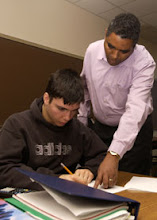That is, the compounding interest rate on student loans—not the
debt load per se that’s killing college graduates and the economy!
OWSers got it partially right with their refrain “student
debt is too damn high,” but politicians trying to jam the interest rate to 6.8%—double
its current rate—are all wrong!
Student loans weigh in at a hefty $1+ trillion dollars, an
amount currently in excess of the collective value of American credit card
debt! A trillion dollars in student loans
with compounding interest at rates at or above 6.8% annually! A banker's dreams, a college graduate's nightmare.
What a simpleton comment…given the billions of taxpayer dollars being doled out to profitable business interests!
Let’s start with the oil industry. In 2011 oil raked in $4 billion in government subsidies. What it bought them: historic profits—$80 billion dollars for the three largest U.S. oil companies. Go Big Oil!
(Source: http://www.whitehouse.gov/blog/2012/03/29/repeal-subsidies-oil-companies)
Moving on to the agricultural industry. Farmers have been milking the taxpayer since 1933. In 2012 farmers pocketed some $5 billion dollars in direct income payments. What it bought us: “high-fructose corn syrup, factory farming, fast food, a two-soda-a-day habit and its accompanying obesity, the near-demise of family farms, monoculture and a host of other ills.” (Source: Don’t End Agricultural Subsidies, Fix Them) And that doesn’t even begin to account for the damage that ensues from our dumping of millions of surplus commodities on world markets….bankruptcy of struggling foreign farmers, decimation of their local markets and intensified poverty and widespread global malnutrition. Let’s add insult to injury: some farmers were actually paid NOT to farm at the tune of another $2.5 billions (2009)!
Student financial aid packages differentiate between subsidized loans awarded on the basis of financial need with interest being charged when repayment begins and unsubsidized loans with capitalized interest accruing from the date of disbursement, i.e., interest compounds during the entire life of the loan. Unsubsidized loans do not require demonstration of need.
Every post-secondary student faces a federal loan limit—both annual and aggregate. For example, a dependent undergraduate student in her first year is limited to $5,500 loan of which no more than $3,500 may be in an interest subsidized Stafford loan. Pit that against the $8,533 average annual pricetag for undergraduate tuition, room and board estimated by the National Center for Education Statistics for 2009-10. (Source: http://nces.ed.gov/fastfacts/display.asp?id=76). How a student meets her remaining educational investment obligation is the student’s problem.Many end up hostage to a commercial loan—an even more untenable situation. An authentic "reverse" Robin Hood ploy—rob from the poorest of the poor, our children, and give to the banking industry—the nation's most recent charity case.
The Congressional Budget Office estimates that freezing the current rate on subsidized Stafford loans at 3.4% will cost $6 billion a year on a program that consistently generates a net profit which is fed into the Pell Grants program to assist low income students.
Contrary to political simpletons, not only should the interest rate not be doubled in July but the government should provide every individual in the country willing to tackle a post-secondary program an interest-free loan! No, better yet, the government can flip the oil and agricultural business subsidies switches off and the human capital investment subsidy switch on. If we’re going to compete in the world of tomorrow, we need to up our investment ante in our future labor force.
Should Congress find that solution too politically distasteful because it “simply kicks the [wrong] can down the road” then let me advocate another.
Each year the Federal Reserve, a for-profit entity, voluntarily gives the US Treasury $80 plus billion dollars of its own earnings. As the real steward of the economy, the Federal Reserve is in a prime position to bankroll the educational investment needed to move this nation’s economy into the 21st century. Allowing post-secondary students to line up for a direct loan from the Federal Reserve is a suggestion with very clear contemporary precedent.
Our nation’s future success in the global economy will be premised on the knowledge wherewithal of our workers. Tomorrow’s workers must begin investment today. When the cost to the individual is too high, investment will not occur, making our slide to the bottom a given. It is in our collective national interest to step up to the plate on this one and make human capital investment our priority #1!
 Kay Strong, Ph.D., Southern Illinois University, M.T., University of Houston, M.A., Ohio University; Associate Professor at Baldwin-Wallace College; Areas of expertise: international economics, contemporary social-economic issues, complexity and futures-based perspectives in economics. E-mail: kstrong@bw.edu
Kay Strong, Ph.D., Southern Illinois University, M.T., University of Houston, M.A., Ohio University; Associate Professor at Baldwin-Wallace College; Areas of expertise: international economics, contemporary social-economic issues, complexity and futures-based perspectives in economics. E-mail: kstrong@bw.edu

This blog is genuinely impressive in all aspects.
ReplyDeletequick pay day loans